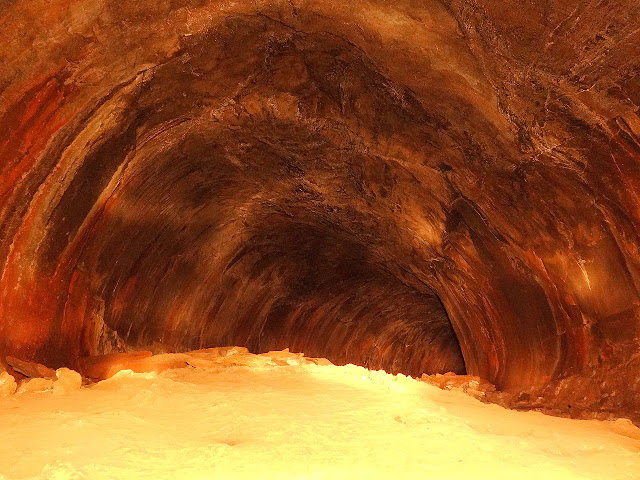Mount
Katmai has long been recognized for its caldera collapse. Mount Katmai rises at
the head of the Valley of Ten Thousand Smokes on the upper Alaska Peninsula,
along the volcanic front of the Aleutian arc.
It’s a large compound stratovolcano that consisted of two contiguous
cones, both beheaded by the caldera collapse of 1912.
Still
many people don’t even hear its name. Mount Katmai is 6.3 miles in diameter
with a central lake-filled caldera about 3 by 2 mi in area. Mount Katmai was
formed during the massive Novarupta eruption in 1912. The sound of the
explosion would be heard in Atlanta and St. Louis, and the fumes observed as
far away as Denver, San Antonio, and Jamaica." (Robert F. Griggs, National
Geographic Magazine, 1917, v. 81 no. 1, p. 50)
In
June 1912, the most spectacular Alaskan eruption in recorded history and the 20th
century's largest measured volcanic eruption formed a large summit caldera at
Katmai volcano. The volcano has caused ten known fatalities due to gas
exposure. The caldera rim reaches a maximum elevation of 6,716 feet. In 1975
the surface of the Crater Lake was at an elevation of about 4,220 feet, and the
estimated elevation of the caldera floor is about 3,400 ft. The flows were
still hot enough to release gases and boil water and would be until the 1980's
Mount
Katmai is centered on the regional drainage divide, the edifice is amazingly
asymmetrical. It was one of largest eruption in the 20th century, ejecting
almost 30 cubic kilometers of ash and debris into the atmosphere. It is well
beating 1991 Pinatubo by a factor of 3 in volume and, for comparison, 1980 Mt.
St. Helens by a factor of 30.
The
magnitude of the eruption can perhaps be best realized if one could imagine a
similar outburst centered in New York City. All of Greater New York would be
buried under from ten to fifteen feet of ash. Philadelphia would be covered by
a foot of gray ash and would be in total darkness for sixty hours. And Washington
and Buffalo would receive a quarter of an inch of ash, with a shorter period of
darkness.
The
mountain is located in Kodiak Island Borough, adjacent to its border with Lake
and Peninsula Borough. The massive eruption happened at a vent about 10 km to
the west of Mount Katmai. More than 60 hours, the volcano eruption took place 28
km³ of ash flows and tephra representing 13 km³ of magma volume. Mount Katmai
consists mainly of lava flows, pyroclastic rocks, and non-welded to
agglutinated air fall.
However,
very little is known about the historical activity of Katmai volcano before
1912 eruption. The Quaternary volcanic rocks at Mount Katmai and nearby cones
are less than 5,000 feet thick. Much of the volcano is mantled by snow and ice
and some valley glaciers radiate out from the flanks. The gigantic eruption
produced a cloud of suffocating gas and ash that blackened the sky for the
inhabitants of the town of Kodiak. The ash falling on them were quickly led to
the harbor and evacuated by boat.
In
1919, geologists noted a lake covering a large part of the caldera floor.
However at the end of 1923 the lake was gone and many fumaroles, mud pots, and
a large mud geyser had replaced it. Please keep in mind that Mount Katmai
should not be climbed without mountaineering skills and equipment. Because high
winds, regular rain and drizzle, brown bears, icy stream crossings, crevassed
glaciers, and particularly its remoteness make the area a true wilderness. But
it’s exhilarating and risky, occasionally wonderful, rarely comfortable, and
never to be trifled with.
The
withdrawal of magma beneath Katmai resulted in the collapse of the summit area,
forming the caldera. After the subsidence, a small dacitic lava dome recognized
as “Horseshoe Island” was emplaced on the floor of the caldera. That is the
only juvenile material erupted from Katmai caldera during the historical
eruption. It was visible at the time of the expedition in 1916.
After
that it has since been submerged by the Crater Lake. Still, the eruption from
Katmai had a VEI of 3, and possibly involved phreatic eruptions. The nearby
Trident, Griggs, and Snowy Mountain volcanoes became active long before Mount
Katmai, and activity at Mageik volcano began about the same time as at Katmai.
The
massive eruption had a decadal impact of wildlife, affecting the spawning of
salmon in the rivers near Novarupta for years. The Mount Katmai cluster was
built on a set of rugged glaciated ridges, marine siltstone and sandstone of
the Jurassic Naknek Formation. The lake has since refilled to a depth of over
800 feet. Moreover, small glaciers have also formed on a bench within the
caldera beside the lake. Pumice still floats on Naknek Lake nearby.
Access
is difficult because the Katmai cluster lies completely within the Roadless
wilderness of Katmai National Park. The only convenient access is by boat or
amphibious aircraft from King Salmon to Brooks Camp on Naknek Lake. The
fascination with the eruption goes beyond the size of the event.
Modern
geology had never seen the deposition of such a large ash flow sheet. So it was
the first time geologists could examine first-hand how the sheet cools and
welds after an eruption. Overall, the 1912 eruption shows how interconnected
magmatic systems in a cluster of volcanoes might be. The area of the Alaska
Peninsula is still sparsely populated, but important things occurred nearby
actually, directly above: air traffic.
Not
only would the trans-Pacific lines be affected by ash of a Novarupta-scale
event, but the ash fallout distribution shows that the potential exists for air
travel across much of Canada and the northern United States (especially
Seattle, Portland, Vancouver) to be halted. Thankfully, the eruption only
lasted 60 hours, but it took at least a week for the ash to settle out of the
atmosphere.
Today, only infrequent earthquake swarms occur in the Katmai Cluster and
many of the hydrothermal features created during the 1912 eruption are dead.
However, the eruption at Novarupta does show the potential for a new colossal
eruption to occur where none has happened in the geologically-recent past.
Hence a reminder of how vital volcano monitoring and research can be in helping
notice the signs of such an event well in advance.
Source: CP























































